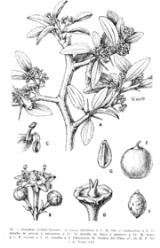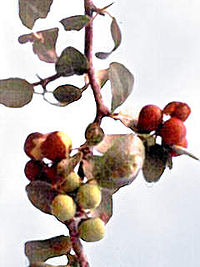
Ziziphus mistol
Encyclopedia

Rhamnaceae
Rhamnaceae, the Buckthorn family, is a large family of flowering plants, mostly trees, shrubs and some vines.The family contains 50-60 genera and approximately 870-900 species. The Rhamnaceae have a worldwide distribution, but are more common in the subtropical and tropical regions...
, that belongs to genus Ziziphus
Ziziphus
Ziziphus is a genus of about 40 species of spiny shrubs and small trees in the buckthorn family, Rhamnaceae, distributed in the warm-temperate and subtropical regions throughout the world. The leaves are alternate, entire, with three prominent basal veins, and long; some species are deciduous,...
, natural (and very abundant) of certain areas of Gran Chaco
Gran Chaco
The Gran Chaco is a sparsely populated, hot and semi-arid lowland region of the Río de la Plata basin, divided among eastern Bolivia, Paraguay, northern Argentina and a portion of the Brazilian states of Mato Grosso and Mato Grosso do Sul, where it is connected with the Pantanal region...
, South America
South America
South America is a continent situated in the Western Hemisphere, mostly in the Southern Hemisphere, with a relatively small portion in the Northern Hemisphere. The continent is also considered a subcontinent of the Americas. It is bordered on the west by the Pacific Ocean and on the north and east...
. The word "mistol" derives from colonial era Spanish, from the word "mixture" (mezcla) since it was believed that mistol was a hybrid between species of genus Schinopsis
Schinopsis
Schinopsis is a genus of South American trees in the family Anacardiaceae. The species within this genus inhabit different regions of the Gran Chaco ecoregion including parts of northern Argentina, Bolivia, and Paraguay....
because of the likely color of its wood to Spaniard colonists' perception.
Morphology
The mistol varies greatly in height, it may reach 10 to 15 meters though most individuals have no more than 4 to 9 meters high. Trunk diameter is also variable, it ranges 20 to 60 centimeters. The branches are pubescent, abundant, with spines near the leaves, and arranged in zig-zag. Its foliage is semi-deciduousSemi-deciduous
Semi-deciduous is a botanical term which refers to plants that lose part of their foliage, also Semi-deciduous plants can mean, that plants can lose their foliage for a very short period, when old leaves fall off and new foliage growth is starting. This phenomenon occurs in tropical and...
. Mistol leaves are oval shaped, alternate, entire, with three prominent basal veins, 2–7 cm long and slightly petiolated. It flowers late in spring, from October to December and fructifies from November to march. The fruit is an edible drupe, reddish-hazel coloured, roughly spherical, 1–5 cm long, sweet and sugary, with a distinct bitterness when ripe.
Mistol wood is quite tough, heavy and enduring (hence its early confusion with that of Schinopsis genus). It is often used in hand held tools, carriage wheels and less frequently to produce slow burning coal.
Usage
Known for centuries before Spanish colonization of Gran Chaco, the mistol was a regular (or even key) dietary item for several local tribes of South American IndiansIndigenous peoples in South America
American indigenous peoples in South America include:*Indigenous peoples in Argentina*Indigenous peoples in Bolivia*Indigenous peoples in Brazil*Indigenous peoples in Chile*Indigenous peoples in Colombia*Indigenous peoples in Ecuador...
(comechingons
Comechingón
Comechingón is the common name for a group of people indigenous to the Argentine provinces of Córdoba and San Luis...
, diaguita
Diaguita
The Diaguita, also called Diaguita-Calchaquí, are a group of South American indigenous peoples. The Diaguita culture developed between the 8th and 16th centuries in what are now the provinces of Salta, Catamarca, La Rioja and Tucumán in northwestern Argentina, and in the Atacama and Coquimbo...
s, quilmes
Quilmes (tribe)
The Quilmes people were an indigenous tribe of the Diaguita group settled in the western subandean valleys of today’s Tucumán province, in northwestern Argentina. They fiercely resisted the Inca invasions of the 15th century, and continued to resist the Spaniards for 130 years, until being defeated...
, etc.). It can be eaten natural when ripe or processed. A known preparation with mistol fruit is arrope
Arrope
Arrope is a form of grape concentrate typically produced in Spain. Often derrived from grape varieties such as Pedro Ximénez, it is made by boiling unfermented grape juice until the volume is reduced by at least 50%, and its viscosity reduced to a syrup...
, an overcooked result of its juice, pulp and cane sugar. Mistol coffee is available in South America
South America
South America is a continent situated in the Western Hemisphere, mostly in the Southern Hemisphere, with a relatively small portion in the Northern Hemisphere. The continent is also considered a subcontinent of the Americas. It is bordered on the west by the Pacific Ocean and on the north and east...
n diet shops, it is becoming slowly popular because it contains almost no caffeine
Caffeine
Caffeine is a bitter, white crystalline xanthine alkaloid that acts as a stimulant drug. Caffeine is found in varying quantities in the seeds, leaves, and fruit of some plants, where it acts as a natural pesticide that paralyzes and kills certain insects feeding on the plants...
or other xanthine alkaloids.

